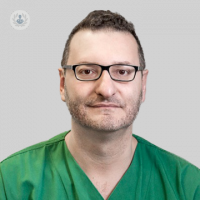Morbid obesity, comprehensive treatment
Written by:Morbid obesity is a chronic disease characterized by excessive accumulation of fat in the body to a point where it puts at risk the health and life of the individual. Morbid obesity is considered when the body mass index (BMI) is from 35%. When it exceeds 40%, the patient is a candidate for surgical treatment.
Obesity morbid causes
 There is no definite genetic predisposition. For the statistics we know some causes as well as their prevalence:
There is no definite genetic predisposition. For the statistics we know some causes as well as their prevalence:
- It is more common in women than in men
- The prevalence of OM is between 45-64 years
- It is more frequent in rural than in urban areas
- There is a greater presence in the lower socio-economic level
- The abuse of fatty foods, the deterioration of the Mediterranean diet and bad habits increase OM
- The sedentary lifestyle
Morbid obesity, health consequences
Morbid obesity causes a decrease in the quantity and quality of life. It affects directly by systems, by importance and frequency:
a) Atherosclerotic cardiovascular disease: Ischemic heart disease; Cerebrovascular disease.
b) Other cardiorespiratory alterations: Congestive heart failure; Arterial hypertension; Ventilatory insufficiency; Obstructive sleep apnea syndrome.
c) Metabolic alterations: Resistance to insulin and type 2 diabetes; Atherogenic dyslipidemia; Hyperuricemia.
d) Alterations of the woman: Menstrual dysfunction; Polycystic ovarian syndrome; Infertility; Increased perinatal risk; Urinary incontinence.
d) Digestive: Cholelithiasis; Hepatic steatosis, non-alcoholic steatohepatitis; Cirrhosis; Gastroesophageal reflux, hiatal hernia.
e) Musculoskeletal: Osteoarthritis; Joint injuries; Bone deformities:
f) Other alterations: Peripheral venous insufficiency; Thromboembolic disease; Cancer (woman: gallbladder and bile ducts, breast and endometrium in postmenopause, man: colon, rectum and prostate). Benign endocranial hypertension. Skin alterations (stretch marks, acanthosis nigricans, hirsutism, folliculitis, intertrigo). Psychological alterations (eating behavior disorders). Psychosocial disorders.
g) Decreased quality of life.
Morbid obesity, operation
a) For obesity border line (below or around 40% of BMI), our unit uses the ability system and in its defect the intragastric balloon. The ABILITY SYSTEM has a mechanism of action that is collected in the operating sheet and detects the intake and feedback to the stomach with a feeling of satiety, helping re-education in the intake.
b) For obesities above 40%, short gastric bypass with associated gastric reduction.
c) Superobesities (above 50%), first intragastric balloon and posterior long gastric bypass.
Morbid obesity, postoperative
The recovery will depend on each case of the intervention performed.
In the case of short or long gastric bypass with gastric reduction, the oral feeding is restarted in 48 hours and after no more than 5 days, if there are no incidences the patient may be high. It begins a process of food re-education that lasts for months, but with a resumption of usual physical activity and even work in no more than 4-6 weeks.
In the case of the ability, the time is substantially reduced, having an ambulatory surgical character with income cut to no more than 2 days. Restart of physical activity and work in 2 weeks.
In the case of the intragastric balloon, it is an endoscopic approach that does not interfere with normal life.
Results of the operation
Gastric bypass passes through the technique with greater efficiency and less side effects than those described. Approximately 95% of the patients reduce their weight and almost 85-90% of the patients maintain the weight loss at 5 years.
Regarding the ability, there is evidence that presents a parallel behavior to the 5 years of maintenance of the descent but a percentage reduction of weight of less than 95% of the by pass .
Regarding the intragastric balloon as it is a temporary or transient situation, it is not evaluable according to these criteria. In general, most individuals, if they are not subjected to another action (when it is the first step) or the need for weight loss (the aforementioned example of surgery for hip prosthesis) ceases to regain weight.



